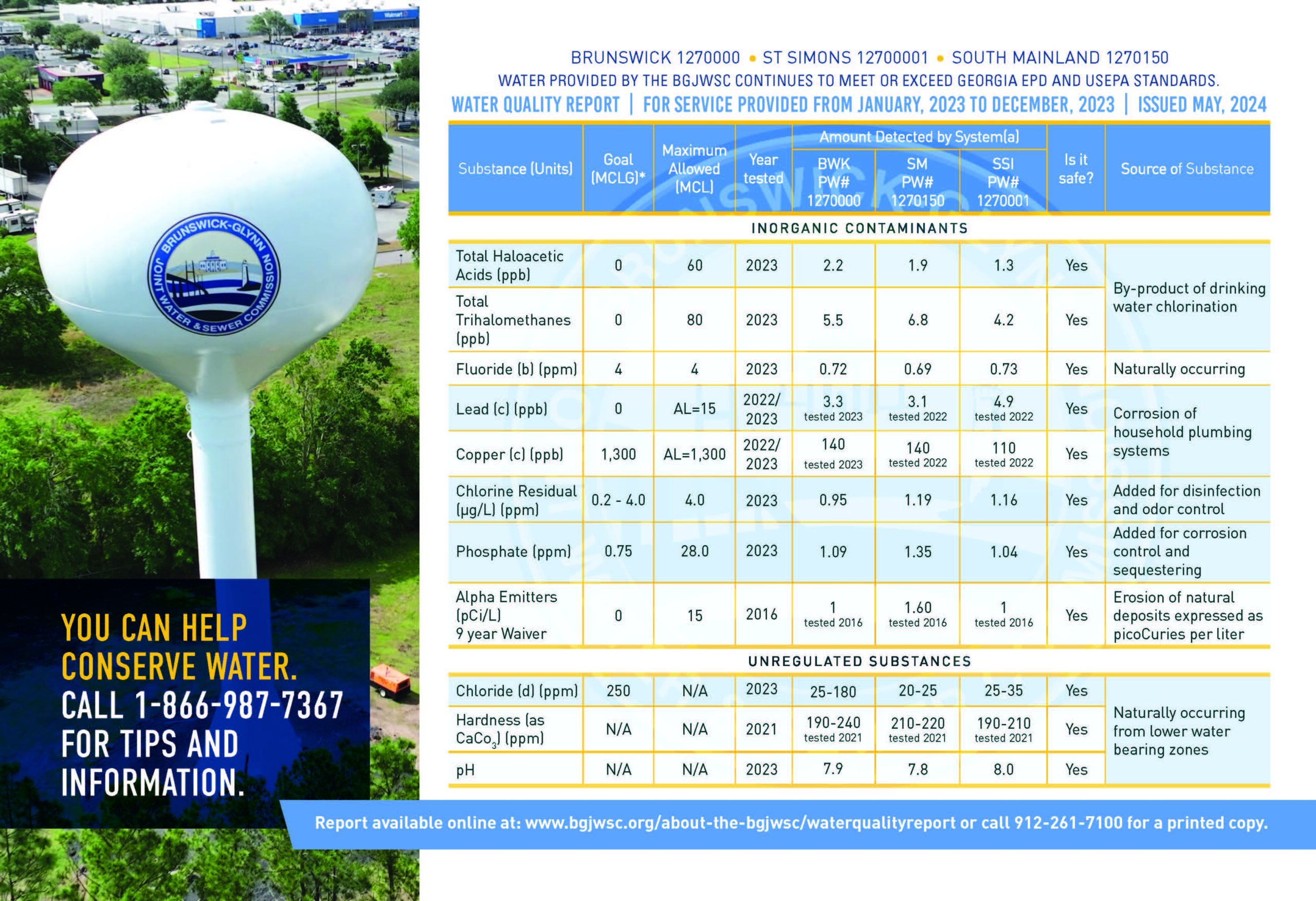Water Quality Report
The JWSC is proud to announce that the water provided to its customers meets or exceeds all environmental requirements of the state and federal governments for the following systems:
- Brunswick District Brunswick-Glynn JWSC – GA1270000
- St. Simons Island Brunswick-Glynn JWSC – GA1270001
- South Mainland District Brunswick-Glynn JWSC – GA1270150
Our abridged Water Quality Report for service provided from January 2023 to December 2023 is shown below.
You can also download a full copy of the report here: BGJWSC_All_Systems_Water_Quality_Report_2023
Water is a basic need for life. Without it, life could not exist. Most people depend on public water supplies for their drinking water. Even though only a small portion of water sold is used for drinking and cooking, all the water produced and distributed must be of high quality-good enough for human consumption. We all depend on our water supply to be protected from contaminants that could threaten our health.
The water for the JWSC system comes from deep underground. The source is a porous limestone structure called the Upper Floridan Aquifer. There are eight wells drilled into the part of the limestone that is carrying the water. The wells range in depth from 750 to 1050 feet, with half of them between 800 to 850 feet.
Water with high levels of chloride from deeper in the earth moving upwards is threatening water quality in the Brunswick peninsula. Ancient brine has been pulled upwards and has contaminated a large portion of the aquifer in the Brunswick area.
The Georgia Environmental Protection Division (EPD) of the Department of Natural Resources has performed a Ground Water Source Vulnerability Risk Assessment. The report, dated June 16, 1999, is available in the Office of the Director.
Some people may be more vulnerable to contaminants in drinking water than the general population. Immune-comprised persons such as persons with cancer undergoing chemotherapy, persons who have undergone organ transplants, persons with HIV/AIDS or other immune system disorders, some elderly, and infants can be particularly at risk from infections. These people should seek advice about drinking water from their health care providers. EPA/CDC guidelines on appropriate means to lessen the risk of infection by Cryptosporidium and other microbial contaminants are available from the Safe Drinking Water Hotline (1-800-426-4791).
Contaminants that may be present in source water include:
- Microbial contaminants, such as viruses and bacteria, which may come from sewage treatment plants, septic systems, agricultural livestock operations and wildlife.
- Inorganic contaminants, such as salts and metals, which can be naturally occurring or result from urban storm water runoff, industrial or domestic wastewater discharges, oil and gas production, mining and farming.
- Pesticides and herbicides, which may come from a variety of sources such as agriculture, urban storm water runoff, and residential uses.
- Organic chemical contaminants, including synthetic and volatile organic chemicals, which are byproducts of industrial processes and petroleum production, and can also come from gas stations, urban storm water runoff and septic systems.
- Radioactive contaminants, which can be naturally occurring or be the result of oil and gas production and mining activities.
In order to ensure that tap water is safe to drink, the United State Environmental Protection Agency (EPA) prescribes regulations which limit the amount of certain contaminants in water provided by public water systems. Food and Drug Administration regulations establish limits for contaminants in bottled water which must provide the same protection for public health.
The JWSC provides the water quality report below annually with details about contaminants, their recorded levels within each system and the related limits. Drinking water, including bottled water, may reasonably be expected to contain at least small amounts of some contaminants. The presence of contaminants does not necessarily indicate that water poses a health risk. More information about contaminants and potential health effects can obtained by calling the EPA’s Safe Drinking Water Hotline (1-800-426-4791).
Lead in Drinking Water
If present, elevated levels of lead can cause serious health problems, especially for pregnant women and young children. Lead in drinking water is primarily from materials and components associated with service lines and home plumbing. The JWSC is responsible for providing high quality drinking water, but cannot control the variety of materials used in plumbing components. When your water has been sitting for several hours, you can minimize the potential for lead exposure by flushing your tap for 30 seconds to 2 minutes before using water for drinking or cooking. If you are concerned about lead in your water, you may wish to have your water tested. Information on lead in drinking water, testing methods, and steps you can take to minimize exposure is available from the Safe Water Hotline or at http://www.epa.gov/safewater/lead.
If you have any questions about this water quality report or would like additional information about the water system, please contact the Office of the Director at our headquarters at 1703 Gloucester St in Brunswick.
